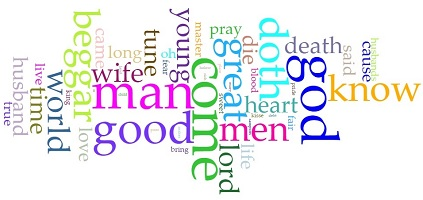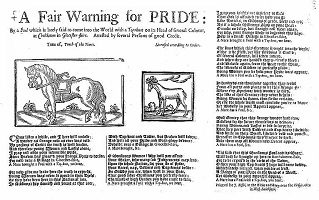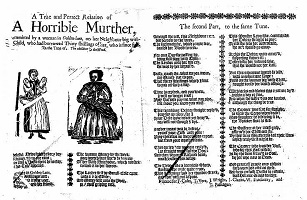Broadside Ballads and Gender Theory
Broadside ballads played an integral role in English life in the seventeenth century. Broadsides were large piece of paper that would often have an image at the top followed by text. The text that was included could be simply classical stories or new stories that allowed authors to discuss political issues of the time. In a way, they were not only a news sources but sources of entertainment. The ballads also had a tune that would go with them. This enabled the ballads to be sung as well as read aloud. Broadsides ballads were large, one - sided pieces of parchment which contained the image and text discussed previously. Ballad sellers sold broadsides in a village or town squares for half a penny. People of this era found ballads posted on walls in a village much like flyers today. Leslie Shepard's book The Broadside Ballad: A Study in Origins and Meanings examines the large variety of subjects that broadsides could be written about such as politics, religion, and history (Shepard, 24-26). In this project, I will be examining how broadside authors deployed gendered language, imagery, and themes. My analysis will consider how authors viewed the state of gender relations and public order. The key to understanding the gendered nature of broadside ballads, one must understand how gender roles were understood in the early modern period. Susan Amussen explains in her monograph An Ordered Society: Gender and Class in Early Modern England that family structure and government structure mirrored the organization of the Kingdom of Heaven (Amussen, 1). The father ruled as head of the family over women, children and servants, just as God ruled in Heaven. The father's rule was absolute. Both men and Women accepted this notion as the ideal. Needless to say, the reality often fell far short of this ideal as Merry Wiesner-Hanks explores in her book Women and Gender in Early Modern Europe. Tim Stretton argues that the law prevented women from becoming judges, serving on juries or in parliament, and did not allow them to vote. He also explains that women who were married, femes covert, were no longer a legal entity and could only enter into contracts or defend herself in court with the assistance of her husband. How women experienced gender also depended on their class and where they lived. Women of lower classes are going to have more work than women of the upper class. However, the tasks will vary from rural to urban life. This project relies upon the methodology of gender analysis. Historian, Joan Scott's article "Gender: A Useful Category of Historical Analysis" explains that just like any other methodology gender can influence many parts of history. Scott explains that gender is a method that can be subjective to the author's opinions. It is also can affect many other things such as politics, economy, and social history. Her definition of gender explains that gender is an organizational element of social relationships that she bases on what is perceived to be different between the sexes (Scott,1067-1068). Gender is used as a primary way to show relationships of power. Scott then goes on to explain that that cultural symbols offer multiple and sometimes contradictory representations. She uses the examples of Eve and Mary. Eve is often viewed as temptress, seductress, and corrupted, while Mary is viewed as innocent and pure. Scholars express these concepts in religious, educational, legal, and political doctrines, which all typically took a fixed binary form. Scott then goes on to explain that when one position dominates it is then shown to be the only option available.
Visualization of Women in Broadsides

This section examines visual representations of the different ways broadside authors referred to women. This section also examines the context in which women are referred two, and themes that are prevalent in seventeenth century broadsides.
Representations of Prideful and Vainity Women

This section examines how broadside authors depict women who are proud and vain. This section also examines the repercussions that broadside authors threaten could befall proud and vain women.
Represenatation of Faithless Women

This section examines how broadside authors often depict women who do not faithless by not fulfilling their wifely duties. This section also examines how men are depicted with an unruly wife.
